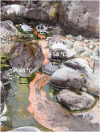Diurnal Changes in Active Carbon and Nitrogen Pathways Along the Temperature Gradient in Porcelana Hot Spring Microbial Mat
- PMID: 30333812
- PMCID: PMC6176055
- DOI: 10.3389/fmicb.2018.02353
Diurnal Changes in Active Carbon and Nitrogen Pathways Along the Temperature Gradient in Porcelana Hot Spring Microbial Mat
Abstract
Composition, carbon and nitrogen uptake, and gene transcription of microbial mat communities in Porcelana neutral hot spring (Northern Chilean Patagonia) were analyzed using metagenomics, metatranscriptomics and isotopically labeled carbon (H13CO3) and nitrogen (15NH4Cl and K15NO3) assimilation rates. The microbial mat community included 31 phyla, of which only Cyanobacteria and Chloroflexi were dominant. At 58°C both phyla co-occurred, with similar contributions in relative abundances in metagenomes and total transcriptional activity. At 66°C, filamentous anoxygenic phototrophic Chloroflexi were >90% responsible for the total transcriptional activity recovered, while Cyanobacteria contributed most metagenomics and metatranscriptomics reads at 48°C. According to such reads, phototrophy was carried out both through oxygenic photosynthesis by Cyanobacteria (mostly Mastigocladus) and anoxygenic phototrophy due mainly to Chloroflexi. Inorganic carbon assimilation through the Calvin-Benson cycle was almost exclusively due to Mastigocladus, which was the main primary producer at lower temperatures. Two other CO2 fixation pathways were active at certain times and temperatures as indicated by transcripts: 3-hydroxypropionate (3-HP) bi-cycle due to Chloroflexi and 3-hydroxypropionate-4-hydroxybutyrate (HH) cycle carried out by Thaumarchaeota. The active transcription of the genes involved in these C-fixation pathways correlated with high in situ determined carbon fixation rates. In situ measurements of ammonia assimilation and nitrogen fixation (exclusively attributed to Cyanobacteria and mostly to Mastigocladus sp.) showed these were the most important nitrogen acquisition pathways at 58 and 48°C. At 66°C ammonia oxidation genes were actively transcribed (mostly due to Thaumarchaeota). Reads indicated that denitrification was present as a nitrogen sink at all temperatures and that dissimilatory nitrate reduction to ammonia (DNRA) contributed very little. The combination of metagenomic and metatranscriptomic analysis with in situ assimilation rates, allowed the reconstruction of day and night carbon and nitrogen assimilation pathways together with the contribution of keystone microorganisms in this natural hot spring microbial mat.
Keywords: Cyanobacteria; carbon and nitrogen assimilation; metagenomics; metatranscriptomics; microbial mat; neutral hot spring; photosynthesis.
Figures






References
-
- Alcamán M. E., Alcorta J., Bergman B., Vásquez M., Díez B. (2017). Physiological and gene expression responses to nitrogen regimes and temperatures in Mastigocladus sp. strain CHP1, a predominant thermotolerant cyanobacterium of hot springs. Syst. Appl. Microbiol. 40 103–113. 10.1016/j.syapm.2016.11.007 - DOI - PubMed
LinkOut - more resources
Full Text Sources
Molecular Biology Databases
Research Materials
Miscellaneous

